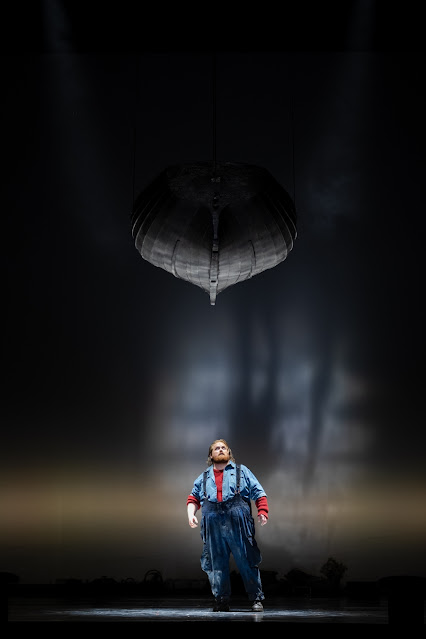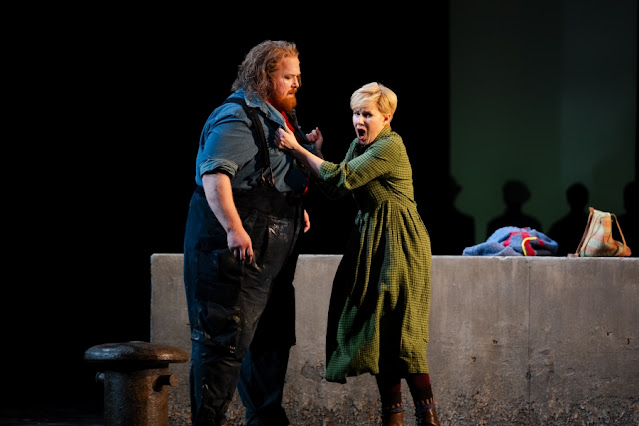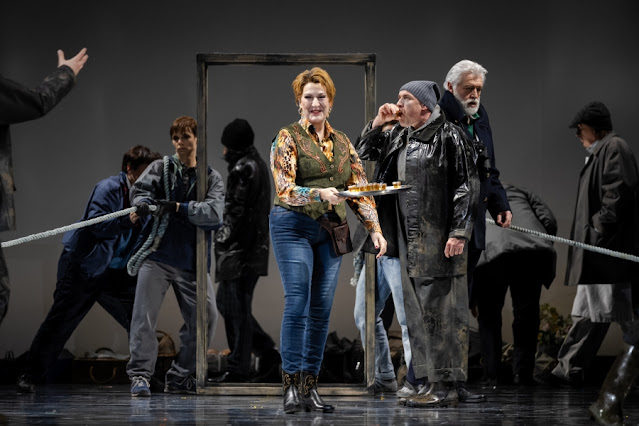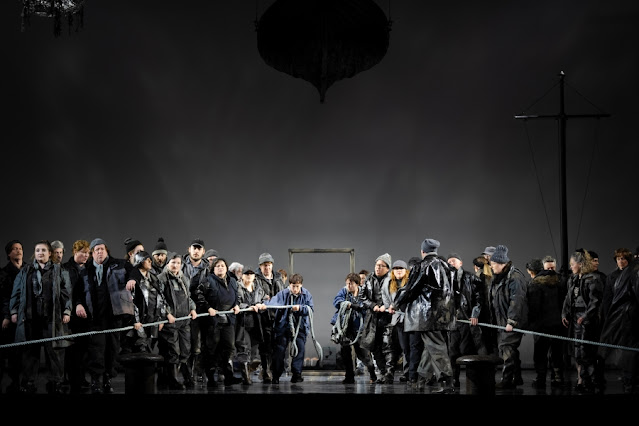 |
| Britten: Peter Grimes – Nicky Spence – Welsh National Opera, 2025 (Photo: Dafydd Owen) |
Britten: Peter Grimes; Nicky Spence, Sally Matthews, David Kempster, director: Melly Still, conductor:Tomáš Hanus, Welsh National Opera; Wales Millennium Centre
Reviewed: 5 April 2025
Nicky Spence’s powerful Peter Grimes at the centre of an intense yet theatrical 1980s-set production in a performance remarkable intensity and sheer communal power
Having caused a stir in 2024 with Olivia Fuchs’ production of Britten’s final opera, Death in Venice, combining opera with circus arts, Welsh National Opera returned to Britten for its major new production of Britten’s first operatic success, Peter Grimes. The opera was something of a marvel when premiered in 1946, and this production had a touch of the miraculous too given the parlous state of WNO’s finances, and the final curtain included chorus members in Save WNO t-shirts, as well as including orchestra and technical staff on stage. Whilst the company’s new general directors, Sarah Crabtree and Adele Thomas, made a stirring speech [catch it WNO’s Twitter feed] though one could net help thinking that with the enthusiastic first night audience they were preaching to the converted and that perhaps the performance should have taken place in the Senedd building next door.
Welsh National Opera‘s new production of Britten’s Peter Grimes opened on Saturday 5 April 2025 at Wales Millennium Centre. Melly Still directed and the company’s music director, Tomáš Hanus conducted. Nicky Spence was Peter Grimes with Sally Matthews as Ellen Orford, David Kempster as Balstrode, Dominic Sedgwick as Ned Keene, Oliver Johnston as Bob Boles, Sarah Connolly as Auntie, Fflur Wyn and Eiry Price as the Nieces, Catherine Wyn-Rogers as Mrs Sedley, Sion Goronwy as Swallow, Jeffrey Lloyd-Roberts as Reverend Horace Adams, Callum Thorpe as Hobson and Maya Marsh as John. Joseph Alford was associate director, Chiara Stephenson was set designer, Ilona Karas was costume designer and lighting designer was Malcolm Rippeth.
 |
| Britten: Peter Grimes – Catherine Wyn-Rogers, David Kempster, Oliver Johnston, Dominic Sedgwick – Welsh National Opera, 2025 (Photo: Dafydd Owen) |
Musically this was of a very high order. Tomáš Hanus drew a marvellous performance from the orchestra, full of vivid colours and with a sense of fierce drama that continued with the chorus too.
Melly Still directed Glyndebourne’s 2022 production of Ethel Smythe’s The Wreckers. [see my review] with its focus on the isolated community in the chorus, and this production of Peter Grimes had a similar focus. Chiara Stephenson’s sets were bleak and spare. At the opening of Act One, we did get a glimpse of the Aldeburgh sea front but largely the production relied on abstract backdrops enlivened by spare stage detail.
Visually, in many scenes, the most dominating feature was a boat suspended above the stage. Traditional in style that the 1980s Peter Grimes probably no longer used, it revealed an array of twinkly lights during Grimes’ ‘Great Bear’ solo in Act One. In the Mad Scene in Act Three, Grimes’ original apprentice climbed into the boat, watching his former master’s mental disintegration.
This visual spareness put the focus of the production on the chorus as community filling the stage with vivid character and scaring the life out of us with the cries of ‘Peter Grimes’ at the end of the first scene in Act Three. This was a community of strong characters, none of whom saw themselves as exceptions.
 |
| Britten: Peter Grimes – Nicky Spence, Sally Matthews – Welsh National Opera, 2025 (Photo: Dafydd Owen) |
For some reason, the setting was the 1980s. Ilona Karas’ costumes and wigs were imaginative and detailed. Callum Thorpe’s Hobson sported a terrific period suit and amazing mullet, whilst Oliver Johnston’s Bob Boles had a similarly dodgy haircut (red, as is Johnston’s natural colouring). Sarah Connolly’s leather jacket wearing Auntie looked straight out of East Enders and her feisty nieces, Fflur Wyn and Eiry Price were pure Grayson Perry heroines.
Nicky Spence, singing his first Peter Grimes, cut a strong and dominating figure, physically imposing and often the still centre of things. From his first bewildered appearance at the inquest there was something other about him, not fitting in (what my elderly aunts would have called ‘touched’). But there was a fierceness too, so that in Act Two his determination almost came over as wrong-headed. In Act One, the ‘Great Bear’ was mesmerisingly beautiful and haunting, hinting at his make-up. Spence’s account of the Mad Scene in Act Three was shot through with this remarkable fierceness. Yet what physical violence there was seemed accidental, a man not in complete control of his physicality, not comfortable within himself.
For the first half of the opera, this Peter Grimes’ relationship with Sally Matthews’ Ellen Orford was far more physically intimate than some. The press of their two bodies together highlighting the their strong physical difference. Matthews was a petite but strong Ellen Orford, upright and distinctly school teacher-like. Matthews’ vibrato led tone gave a warmth to her music but added a tremulous quality too. Yet in act Two, her moral qualities caused her to lose faith in Grimes, which meant him losing his faith in himself.
 |
| Britten: Peter Grimes – Sarah Connolly, David Kempster – Welsh National Opera, 2025 (Photo: Dafydd Owen) |
The treatment of Grimes’ apprentice highlights one of the production’s more unusual features. The apprentice, John, was played as a teenage boy by Maya Marsh, one of the six-person movement group, all six playing teenage boys. One was Grimes’ previous apprentice and an imaginative touch was to have the two apprentices leading Spence’s Grimes off into the sunrise at the end. A more questionable decisions was having the Sea Interludes danced. With Tomáš Hanus and the orchestra on coruscating form, these hardly needed the addition of expressive movement.
David Kempster was a prickly, uneven-tempered Balstrode. Fierce at times, yet upright, doing the right thing yet difficult to deal with an not entirely sympathetic. Sarah Connolly was a strong Auntie, brooking no nonsense and with a smile that suggested she had seen it all before, yet in a way more sympathetic to Grimes than in some productions. Catherine Wyn-Rogers made a wondrous quasi-Hyacinth Bucket of Mrs Sedley, here, rightly the villain of the piece. Dominic Sedgewick was a sympathetic, wide-boy Ned Keened with definitely an eye and more for the ladies. Oliver Johnston as Bob Boles was uncertain of temper and physically explosive, a vivid performance indeed. Jeffrey Lloyd-Roberts was a nicely oily Rev Adams, with Sion Goronwy as a physically upstanding yet morally dubious Swallow with Callum Thorpe as the uptight carter, Hobson. Fflur Wyn and Eiry Price were flirty yet feisty Nieces, strong in character and well able to fend the men off.
This was a visually busy production, so it was a relief that at times, Melly Still calmed down and allowed the music space. One moment was the women’s marvellous quartet in Act Three, here as it should be, a spine-tingling moment.
 |
| Britten: Peter Grimes – Welsh National Opera, 2025 (Photo: Dafydd Owen) |
I think that this was perhaps one of the most disturbing productions of Peter Grimes that I have seen in a long time. The bleak intensity of the way the relationships were played out contrasting with the marvellous colours and imagination in the orchestra and the sheer power of the chorus.
The blog is free, but I’d be delighted if you were to show your appreciation by buying me a coffee.
Elsewhere on this blog
- Telling a musical story: violinist James Ehnes on the challenges of recording of Bach’s violin concertos with Canada’s NAC Orchestra – interview
- Powerful stuff: Ukrainian composer Boris Lyatoshynsky’s dramatic war-inspired symphony alongside Prokofiev’s Semyon Kotko – concert review
- Imagination & sense of drama: John Weldon’s 1701 prize-winning The Judgement of Paris in its first recording from Academy of Ancient Music & Cambridge Handel Opera Co – record review
- Up close and personal: David Butt Philip & Friends Gala at St Paul’s Opera, Clapham – opera review
- Pure enjoyment: Peter Moore & Tredegar Band give the first recording of Simon Dobson’s concerto for Moore – record review
- Bespoke Songs: soprano Fotina Naumenko on commissioning four composers for works for soprano and diverse ensembles – interview
- Richard Strauss at the Deutsche Oper Berlin:
- Elektra & Intermezzo – opera review
- Arabella with Jennifer Davis & Heidi Stober – opera review
- Traces of trauma: Britten Sinfonia premiere Michael Zev Gordon’s A Kind of Haunting marking 80th anniversary of the end of WWII – concert review
- Letter from Florida: Stéphane Denève & New World Symphony on impressive form in Britten’s War Requiem – concert review
- Home









